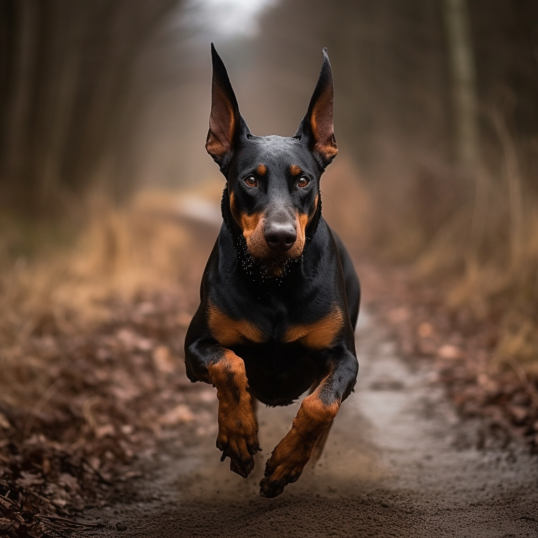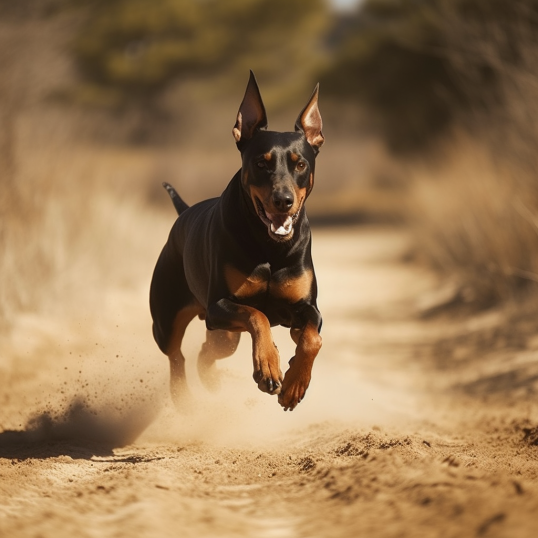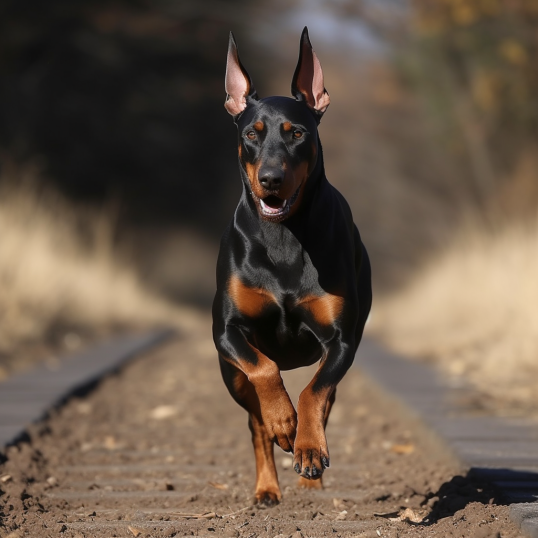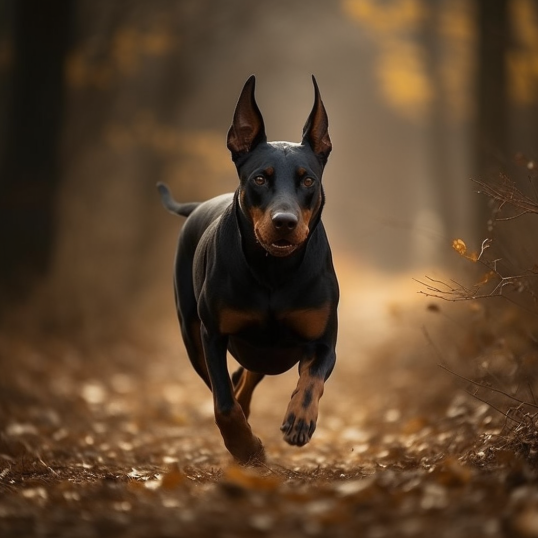Brief Overview of Dobermans
The Doberman Pinscher, or simply the Doberman, is a dog breed that originated in Germany in the late 19th century. Known for its sleek coat, athletic build, and regal appearance, this breed has gained immense popularity worldwide. The Doberman combines a number of traits in its personality and physicality that make it unique. They are intelligent, strong, and extremely loyal dogs, often serving in roles such as police dogs, search and rescue dogs, and therapy dogs.
Importance of Understanding a Doberman’s Physical Capabilities
Understanding a Doberman’s physical capabilities is crucial for anyone considering adopting or buying one. These dogs are energetic and require regular exercise to maintain their health and happiness. Their strength, agility, and speed are part of what makes them such effective working dogs, but these same traits can pose challenges if not properly managed.
For example, a Doberman’s speed can make them a potential risk around small children or other pets if not appropriately trained. On the other hand, their physical prowess can also lead to remarkable achievements in agility training and competitions. By understanding their physical capabilities, you can ensure that you provide a safe and stimulating environment for your Doberman, making the most out of their natural abilities and ensuring their well-being.
The Doberman Breed: A Quick Overview

History and Origin of the Breed
The Doberman breed was first developed in Germany by a tax collector named Louis Dobermann in the late 19th century. He wanted a medium-sized guard dog to accompany him on his rounds. The exact breeds used to create the Doberman are unknown, but it’s believed that the Rottweiler, German Pinscher, Greyhound, and Weimaraner were among the contributors. This mix resulted in a breed that combined speed, endurance, strength, and a fierce loyalty to its owner.
General Physical Characteristics
Dobermans are a picture of elegance and athleticism in the canine world. They typically stand between 24 to 28 inches tall at the shoulder and weigh between 60 to 100 pounds, with females being slightly smaller than males. They have a sleek, muscular build, with a body that’s more square than rectangular. The breed is known for its short, shiny coat which can come in several colors, including black, red, blue, and fawn, all typically with rust-colored markings.
Typical Temperament and Behavior
Dobermans are often stereotyped as aggressive, but in reality, they are usually friendly, intelligent, and extremely loyal dogs. They can be protective when the situation calls for it, but they’re not innately hostile. Their intelligence makes them highly trainable, and they excel in roles that require obedience, problem-solving skills, and agility. They are energetic dogs and require plenty of exercise to keep them mentally and physically stimulated. Despite their tough exterior, Dobermans are known to be sensitive dogs that form strong bonds with their families and do not like being left alone for long periods.
The Speed of a Doberman

Average Speed of a Doberman
One of the standout physical attributes of a Doberman is its speed. Thanks to their lean, muscular build and powerful legs, Dobermans are incredibly fast runners. On average, a healthy, adult Doberman can reach speeds up to 20 to 30 miles per hour. This makes them one of the fastest dog breeds, only slightly trailing behind the Greyhound, which is considered the fastest dog breed in the world.
Factors Influencing a Doberman’s Speed
While Dobermans are naturally fast, several factors can influence their speed:
- Age: Like humans, a dog’s age affects its speed. Puppies and young adults usually run faster than older dogs. As they age, dogs may develop health conditions that can slow them down or make running uncomfortable.
- Health and Fitness Level: A Doberman’s overall health and fitness level significantly impact their speed. Dogs that are overweight or underweight may not run as quickly or for as long as dogs that maintain a healthy weight. Regular exercise and a balanced diet are crucial for keeping your Doberman in top shape.
- Training: Training also plays a vital role in a Doberman’s speed. Although they are naturally athletic, Dobermans can learn to run faster and more efficiently with proper training. Activities like agility training, lure coursing, or even simple fetch games can help improve their speed while also providing mental stimulation.
Understanding these factors can help you ensure your Doberman maintains its speed and agility throughout its life.IV. Comparing the Doberman’s Speed to Other Breeds A. Speed comparison with other similar-sized dogs B. Speed comparison with smaller and larger breeds
Impact of a Doberman’s Speed on Their Care and Lifestyle

Exercise Needs
A Doberman’s speed is a testament to their high-energy nature and athletic build. Consequently, they require a significant amount of exercise to remain healthy and happy. Experts recommend at least one hour of vigorous exercise each day, including activities that allow them to stretch their legs and run at full speed, such as fetch or agility training. Regular exercise not only maintains their physical health but also helps manage their energy levels and reduces the likelihood of behavioral problems.
Training for Speed and Agility
Training your Doberman to harness their speed can be both beneficial and enjoyable. Agility training, in particular, is an excellent way to channel their energy and speed into something constructive. It involves teaching your dog to navigate various obstacles at speed, which can be great fun for both you and your pet. Not only does it provide a physical workout, but it also offers mental stimulation, as it requires concentration and problem-solving skills.
Potential Issues Related to Their Speed
While a Doberman’s speed is generally a positive trait, it can also lead to certain issues. For example, their ability to sprint quickly makes them potential escape artists. If they get loose, they can cover a large area very quickly, which could put them in danger. Therefore, it’s essential to have a secure yard and to keep them on a leash when in public places.
Their speed can also pose safety risks, particularly around young children or elderly people, as they can easily knock someone over if they’re running at full speed. Therefore, it’s important to train them from a young age to control their speed around people.
Understanding the impact of a Doberman’s speed on their care and lifestyle will help you provide a suitable environment for them, keeping them safe, healthy, and happy.
Conclusion: Embracing the Speed of a Doberman

Recap of Key Points
We have journeyed through the world of the Doberman breed, exploring their history and the physical attributes that contribute to their impressive speed. We have highlighted how factors such as age, health, and training can impact this speed, and how their swift nature impacts their care and lifestyle. From their exercise needs to the potential issues related to their speed, we’ve delved into the unique aspects that make up the life of a Doberman.
Final Thoughts on the Importance of Understanding and Accommodating a Doberman’s Speed.
Understanding a Doberman’s speed is not just about appreciating their athletic prowess. It’s about recognizing an integral part of their character and catering to it through proper care, exercise, and training. Their speed, agility, and energy are entwined with their intelligence, loyalty, and protective nature, giving us the Doberman breed we know and love.
Embrace your Doberman’s speed. Channel it through regular exercise and agility training, but remember to manage it wisely, keeping them safe and secure. By doing so, you’ll not only be meeting their physical needs but also enriching their mental well-being. After all, a happy, healthy, and well-exercised Doberman is a joy to be around.
References
While writing this blog, the information was gathered from a variety of trusted and reliable sources to ensure accuracy and reliability. Here are the references used in the compilation of this blog:
- American Kennel Club. (n.d.). Doberman Pinscher Dog Breed Information. Retrieved from AKC
- Mehus-Roe, K. (2011). Dog Bible: The Definitive Source for All Things Dog. BowTie Press.
- Coren, S. (2005). The Intelligence of Dogs: A Guide To The Thoughts, Emotions, And Inner Lives Of Our Canine Companions. Free Press.
- Fogle, B. (2009). The Dog’s Mind: Understanding Your Dog’s Behavior. Howell Book House.
Please note that while these sources provide general information about Dobermans, individual dogs may vary. Always consult with a professional or your vet for advice tailored to your specific pet.
